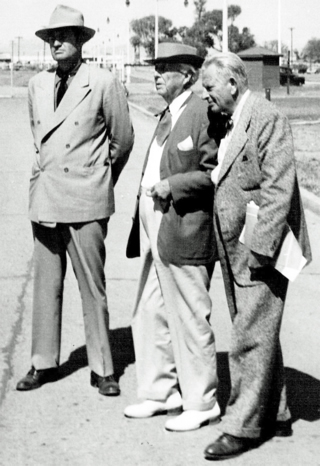Visionaries on the Wing - Page 3
They began working on the proposal in 1947, producing a miniature of what would become the Butterfly Bridge for a river in Spring Green, Wisconsin, near Wright's complex, Taliesen. It was never built.
Working in Taliesen in 1949, Wright and Polivka came up with at least four designs for the Butterfly Bridge, according to a 1953 article in Pacific Road Builder and Engineering Review. The plans had various numbers of lanes, some carried public transit and some did not, and some did not have a central park.
"Frank Lloyd Wright, the precedent-shattering dean of 20th century architecture, has designed an earthquake-proof bridge for San Francisco's proposed southern crossing," the Examiner announced in June 1949.
Wright and Polivka urged acceptance of their plan, citing its beauty and cost. Polivka said the bridge would cost up to $100 million less than competing plans because of its simplicity and lightness.
 |
|
|
Polivka was clearly the driving force behind the proposal, peppering reporters with updates and even sending President Truman "a long telegram and a letter." He repeatedly wrote "Mr. Wright" about the bridge and heard little back, as revealed in correspondence from the Frank Lloyd Wright Archive.
"Will chime in when the time comes," Wright promised in a three-line 1949 letter to Polivka.
As talk turned to building a northern crossing as well as southern crossing, Wright and Polivka proposed a similar Butterfly span to run from Berkeley to Angel Island, Alcatraz, and Marin.
In 1950, meanwhile, Polivka came up with designs on his own for the proposed Richmond-San Rafael Bridge, arguing that the preferred plan was "antiquated" and needlessly expensive. "All [my] suggestions were thrown in the waste basket," he wrote in his memoir.
In 1953, as revealed in the Wright correspondence, architect Aaron Green, who ran Wright's office in San Francisco, reported that a winery truss roof designed by Polivka had collapsed.
Polivka blamed poor construction, but "the damage to his reputation, whether justified or not, is irreparable," Green advised Wright. "The bridge is your design and not Polivka's," he continued. Wright briefly considered replacing Polivka with another engineer, according to a letter in the Wright archive.
Polivka finally convinced Wright to make an appearance on the bridge's behalf. Wright made his final push for the Butterfly Bridge in April 1953, speaking on 'Bridging the Bay: Cement and Aesthetics' at the San Francisco Museum of Modern Art, several days after the plan was submitted to the city's mayor.
In fact, it's not clear if the Wright-Polivka plan was ever formally rejected, or even taken seriously by state and regional planners. They never got around to considering bridge designs because they could never decide where the bridge should be built.
San Franciscans favored a southern crossing that would have run, roughly and with some variants, from downtown Oakland and Alameda to Army Street (now Cesar Chavez Street) or points south in San Francisco. No exact location was ever finalized. Oakland favored a bridge to the north, running alongside the existing span.
Negotiations between the two cities collapsed a month after Wright made his presentation. Skirmishes between the two sides continued intermittently for a few more years, but by 1957 another player had emerged—BARTD, as the transit district was originally called, the 'D' standing for District.
Harry A. Mitchell, chair of the Bay Area Rapid Transit Commission, enjoyed Wright's presentation but argued that, no matter what a new bridge looked like or where it was sited, "we still have to get rid of the automobiles when they arrive at their destination."
He suggested that Wright design instead "a supporting structure for a mass-transit system that will be attractive and artistic."
By March 1959, when the Examiner opted for BART over a new bridge in its editorial 'Southern Crossing or Transit Tube?' it was clear that no new bay bridge would be built—at least for a time.




